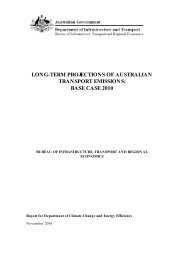Enterprise Agreement 2011-14 - Department of Climate Change
Enterprise Agreement 2011-14 - Department of Climate Change
Enterprise Agreement 2011-14 - Department of Climate Change
You also want an ePaper? Increase the reach of your titles
YUMPU automatically turns print PDFs into web optimized ePapers that Google loves.
<strong>Department</strong> <strong>of</strong> <strong>Climate</strong> <strong>Change</strong> and Energy Efficiency – <strong>Enterprise</strong> <strong>Agreement</strong> <strong>2011</strong>-<strong>14</strong><br />
excess to requirements, the employee will be paid a sum equal to two weeks salary for each<br />
completed year <strong>of</strong> service; plus a pro rata payment for completed months <strong>of</strong> service since<br />
the last completed year <strong>of</strong> service, subject to any minimum amount the employee is entitled<br />
to under the National Employment Standards (NES).<br />
82.2. The minimum sum payable will be 4 weeks’ salary and the maximum will be 48 weeks’<br />
salary.<br />
82.3. The redundancy benefit will be calculated on a pro rata basis for any period where an<br />
employee has worked part-time hours during his or her period <strong>of</strong> service and the employee<br />
has less than 24 years full-time service, subject to any minimum amount the employee is<br />
entitled to under the NES.<br />
83. Notice <strong>of</strong> Termination<br />
83.1. Where the employment <strong>of</strong> an excess employee is to be terminated under s.29 <strong>of</strong> the Public<br />
Service Act 1999 on excess grounds, the Secretary will give written notice <strong>of</strong> termination <strong>of</strong> 4<br />
weeks (or 5 weeks for an employee over 45 with at least five years <strong>of</strong> continuous service).<br />
83.2. Where an employee’s employment is terminated at the beginning <strong>of</strong>, or within, the notice<br />
period, the employee will receive payment in lieu <strong>of</strong> notice for the unexpired portion <strong>of</strong> the<br />
notice period.<br />
84. Calculating Redundancy Payments<br />
84.1. Redundancy payments will be calculated on:<br />
o the employee’s salary at the substantive work value level on the date <strong>of</strong><br />
termination;<br />
o the salary <strong>of</strong> the higher level work value level, where the employee has been<br />
working at the higher level for a continuous period <strong>of</strong> at least 12 months<br />
immediately preceding the date on which the employee is given notice <strong>of</strong><br />
termination; and<br />
o other allowances in the nature <strong>of</strong> salary which are paid during periods <strong>of</strong> annual<br />
leave and on a regular basis, excluding allowances which are a reimbursement for<br />
expenses incurred, or a payment for disabilities associated with the performance <strong>of</strong><br />
duty.<br />
84.2. Where an employee has worked part-time hours during his or her period <strong>of</strong> service and the<br />
employee has less than 24 years full-time service, the 2 weeks per year <strong>of</strong> service that<br />
relates to the part-time service will be paid on pro-rata basis as follows:<br />
o current annual full-time equivalent salary (used for redundancy purposes), divided<br />
by full time hours, multiplied by the part-time hours for that part-time period<br />
worked.<br />
84.3. Subject to Clauses 85.4, 85.5 and 85.6 service for redundancy pay purposes means:<br />
48






